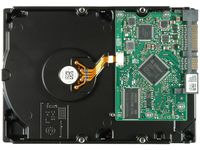1TB Evolves: New Drives, More Speed
Hitachi Deskstar 7K1000.B 1 TB (HDT721010SLA360)
The Deskstar 7K1000 family was put on a strict diet that brought it from a five-platter design down to only three platters; this is the same number used by the new Western Digital Caviar Black drive. As a result, this has also had an impact on the overall weight, which decreased from 700 g with the Deskstar 7K1000 to 680 g for the 7K1000.B.
Capacities, Specifications, Features, Options
Hitachi no longer only offers a single terabyte hard drive, but released a full lineup including capacities of 1 TB, 750 GB, 640 GB, 500 GB, 320 GB, 250 GB and even 160 GB. The two smallest capacity points do not seem to make a lot of sense anymore, though, as they’re based on a single platter that remains largely unused. This Hitachi generation is capable of storing at least 333 GB onto a single platter, making 320 GB the smallest sensible capacity.
Hitachi ships its 7K1000.B drives with either 8 MB or 16 MB of cache memory, which can only be determined by dissecting the model number. Our sample was a HDT721010SLA360, which can be broken down like so: Hitachi Deskstar T-series (HDT), 7,200 RPM (72), maximum family capacity 1 TB (the first 10), actual capacity (the second 10), the generation (S) and Z-height (L stands for 26.1 mm), the interface (3 = SATA/300) and the cache capacity (6 = 16 MB). Check out the data sheet on the Hitachi GST website for more details. We looked at the performance difference of 8 MB vs. 16 MB cache in March of 2007, and the simple answer is that more cache does not significantly improve performance.
All Deskstar 7K1000.B drives spin at the standard 7,200 RPM speed, but they are much more efficient than their predecessors as a result of the decreased platter count. This becomes obvious after a quick look into Hitachi’s 7K1000.B data sheet, as it lists the idle power for the models with three, two and one platter: 5.2 W, 4.4 W and 3.6 W, respectively. We had measured 8.6 W idle power for the older 7K1000 (non-B) and 5.4 W for this latest model. Efficiency is greatly improved as well, as you’ll see in the benchmark section.
Performance: Increased Access Time, Improved Throughput
Increased access times is something we’ve seen with many other hard drives that come with higher data densities. Hitachi used to offer a 13.8 ms average access time for the Deskstar 7K1000, but only reached 17.1 ms average for the new 7K1000.B—this is as fast as a 5,400 RPM notebook hard drive and hence not very impressive at all. However, the I/O performance doesn’t suffer as much as the access time may suggest, and the 7K1000.B also does very well in the PCMark05 Windows XP startup benchmark, which requires both high throughput and lots of random access within a limited area of the drive.
Get Tom's Hardware's best news and in-depth reviews, straight to your inbox.
Throughput, however, increases from 84.9 MB/s to 111.6 MB/s maximum sequential read performance. While this isn’t enough to beat the Caviar Black, the minimum transfer rates are actually a bit higher: 60.6 MB/s for Hitachi as opposed to 54.2 MB/s for WD. With the exception of minimum transfer performance, the two drives are not able to beat Samsung’s Spinpoint F1 in throughput.
Great Efficiency
Hitachi’s promise of “balanced power and performance for desktop performance” is pretty close to what we measured, as the drive showed excellent idle power and the best performance per watt ratio for streaming reads of all 7,200 RPM hard drives. It even manages to outperform WD’s efficient Caviar Green hard drive, which runs at a lower spindle speed. However, it doesn’t get to the top in our workstation I/O benchmark that we use to analyze performance per watt for this type of workload. If you look at the comparison table “old vs. new”, which you’ll find in our conclusion, you’ll see that Hitachi significantly improved its Deskstar drive in all categories except access time, which pretty much matches the marketing message.
Current page: Hitachi Deskstar 7K1000.B 1 TB (HDT721010SLA360)
Prev Page Hitachi, WD: 1-TB Drives Revised Next Page Western Digital Caviar Black 1 TB (WD1001FALS)

